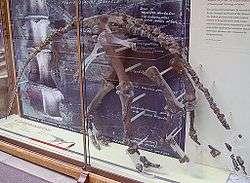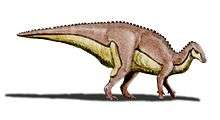Cumnoria
| Cumnoria | |
|---|---|
 | |
| Holotype skeleton, Oxford University Museum of Natural History | |
| Scientific classification | |
| Kingdom: | Animalia |
| Phylum: | Chordata |
| Clade: | Dinosauria |
| Order: | †Ornithischia |
| Suborder: | †Ornithopoda |
| Clade: | †Styracosterna |
| Genus: | †Cumnoria Seeley, 1888 |
| Species | |
| Synonyms | |
| |
Cumnoria is a genus of herbivorous iguanodontian dinosaur. It was a basal iguanodontian that lived during the Late Jurassic period (Kimmeridgian age) in what is now Oxfordshire, United Kingdom.
Description
The holotype of Cumnoria is of a rather small bipedal animal, with a gracile build, about 3.5 metres long. The specimen is probably that of a juvenile though.[1]
History of discovery
Cumnoria is known from the holotype OXFUM J.3303, a partial skull and postcranium, recovered from the lower Kimmeridge Clay Formation, in the Chawley Brick Pits, Cumnor Hurst. Workers at first discarded the remains on a dump heap, but one of them later collected the bones in a sack and showed them to Professor George Rolleston, an anatomist at the nearby Oxford University. Rolleston in turn brought them to the attention of palaeontologist Professor Joseph Prestwich who in 1879 reported them as a new species of Iguanodon, though without actually coining a species name.[2] In 1880 Prestwich published an article on the geological stratigraphy of the find.[3] The same year John Whitaker Hulke named the species Iguanodon prestwichii, the specific epithet honouring Prestwich.[4]
In 1888, Harry Govier Seeley decided the taxon represented a new and separate genus which he named Cumnoria after Cumnor, the village where it was discovered. Its type species Iguanodon prestwichii was thus recombined into Cumnoria prestwichii — though Seeley spelled the epithet as prestwichi.[5] The genus was quickly abandoned however: already in 1889 Richard Lydekker assigned the species to Camptosaurus, as Camptosaurus prestwichii.[6] This opinion was generally accepted for over a century. In 1980 Peter Galton provided the first modern description of the species.[1]
In 1998 David Norman concluded that Seeley's original generic distinction was valid.[7] In 2008 this was supported by Darren Naish and David Martill.[8] In 2010 and 2011 cladistic analyses by Andrew T. McDonald confirmed this by showing that Cumnoria had a separate phylogenetic position from Camptosaurus dispar.[9][10]
Classification
Camptosaurus prestwichii was traditionally assigned to the Camptosauridae. In the new analyses of McDonald Cumnoria has instead been recovered as a basal member of the Styracosterna, more closely related to more derived ("advanced") iguanodontians than to Camptosaurus dispar. Cumnoria would then be the oldest known styracostern.[10]
| Iguanodontia |
| ||||||||||||||||||||||||||||||||||||||||||||||||||||||||||||||||||||||||
References
- 1 2 Galton, P.M.; Powell, H.P. (1980). "The ornithischian dinosaur Camptosaurus prestwichii from the Upper Jurassic of England". Palaeontology. 23: 411–443.
- ↑ Prestwich, J. (1879). "On the discovery of a species of Iguanodon in the Kimmeridge Clay near Oxford; and a notice of a very fossiliferous band of the Shotover Sands". Geological Magazine, new series, decade 2. 6 (5): 193–195. doi:10.1017/s0016756800157000.
- ↑ Prestwich, J. (1880). "Note on the occurrence of a new species of Iguanodon in a brickpit of the Kimmeridge Clay at Cumnor Hurst, three miles W.S.W. of Oxford". Quarterly Journal of the Geological Society of London. 36: 430–432. doi:10.1144/GSL.JGS.1880.036.01-04.35.
- ↑ Hulke, J.W. (1880). "Iguanodon prestwichii, a new species from the Kimmeridge Clay, distinguished from I. mantelli of the Wealden Formation in the S.E. of England and Isle of Wight by differences in the shape of the vertebral centra, by fewer than five sacral vertebrae, by the simpler character of its tooth-serrature, etc., founded on numerous fossil remains lately discovered at Cumnor, near Oxford". Quarterly Journal of the Geological Society of London. 36 (143): 433–456. doi:10.1144/GSL.JGS.1880.036.01-04.36.
- ↑ Seeley, H.G. (1888). "On Cumnoria, an iguanodont genus founded upon the Iguanodon prestwichi, Hulke". Report of the British Association for the Advancement of Science. 57: 698.
- ↑ Lydekker, R. (1889). "On the remains and affinities of five genera of Mesozoic reptiles". Quarterly Journal of the Geological Society. 45: 41–59. doi:10.1144/GSL.JGS.1889.045.01-04.04.
- ↑ Norman, D. (1998). "On Asian ornithopods (Dinosauria: Ornithischia). 3. A new species of iguanodontid dinosaur". Zoological Journal of the Linnean Society. 122: 291–348. doi:10.1111/j.1096-3642.1998.tb02533.x.
- ↑ Naish, D.; Martill, D.M. (2008). "Dinosaurs of Great Britain and the rôle of the Geological Society of London in their discovery: Ornithischia". Journal of the Geological Society of London. 165 (3): 613–623. doi:10.1144/0016-76492007-154.
- ↑ McDonald, A.T.; Kirkland, J.I.; DeBlieux, D.D.; Madsen, S.K.; Cavin, J.; Milner, A.R.C. & Panzarin, L. (2010). "New Basal Iguanodonts from the Cedar Mountain Formation of Utah and the Evolution of Thumb-Spiked Dinosaurs". PLoS ONE. 5 (11): e14075. doi:10.1371/journal.pone.0014075. PMC 2989904. PMID 21124919.
- 1 2 Andrew T. McDonald (2011). "The taxonomy of species assigned to Camptosaurus (Dinosauria: Ornithopoda)" (PDF). Zootaxa. 2783: 52–68.







